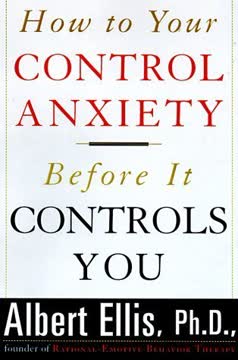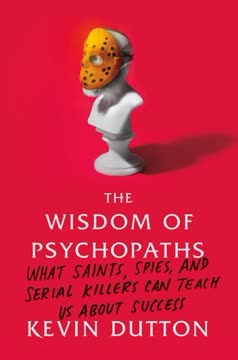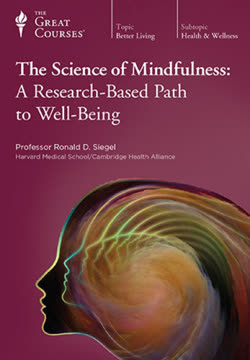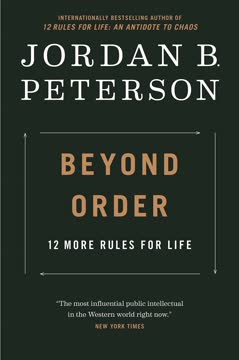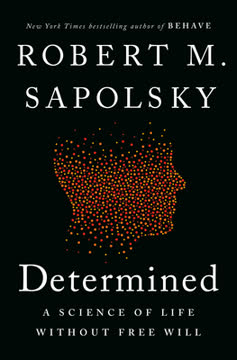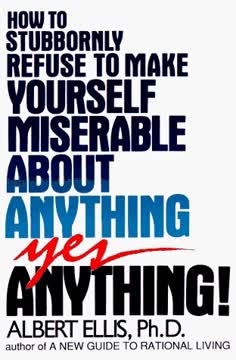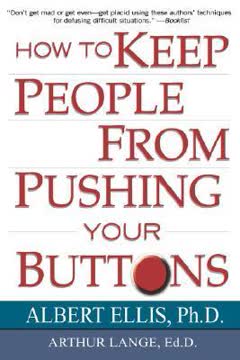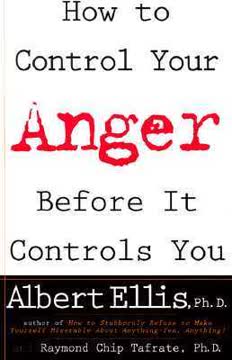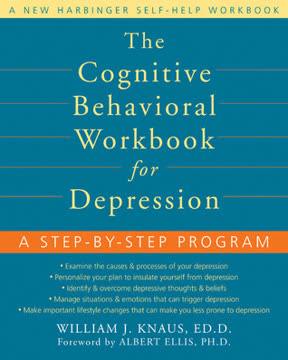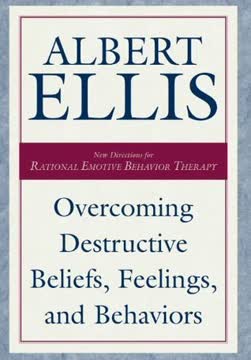Key Takeaways
1. Anxiety is a natural human response, but it can be controlled
"Anxiety, believe it or not, is a good thing that helps keep you alive and comfortable and helps to preserve the human species."
Anxiety serves a purpose. It alerts us to potential dangers and motivates us to take action. However, excessive anxiety can be debilitating. The key is to distinguish between healthy concern and unhealthy anxiety. Healthy concern leads to productive action, while unhealthy anxiety often paralyzes us or leads to counterproductive behaviors.
Anxiety can be managed. While we may not have complete control over external events, we have significant control over our reactions to them. By understanding the mechanisms of anxiety and learning effective coping strategies, we can prevent anxiety from controlling our lives. This involves recognizing our thought patterns, challenging irrational beliefs, and developing healthier ways of thinking and responding to stressors.
2. Irrational beliefs are the root cause of excessive anxiety
"Assuming that REBT is correct, and that your wants and preferences do not create anxiety when they are not fulfilled but that your musts and demands often do lead to it, you may then see that accompanying your anxiety-creating musts are several corollary or derivative Beliefs that strongly tend to go with them and that increase your anxiety."
Identify irrational beliefs. The core of excessive anxiety often lies in our irrational beliefs, particularly those involving absolute "musts" and "shoulds." These beliefs typically fall into three categories:
- Demands on oneself: "I must be perfect"
- Demands on others: "Others must treat me fairly"
- Demands on the world: "Life must be easy"
Recognize derivative beliefs. Accompanying these core irrational beliefs are often:
- Awfulizing: "It's terrible if I fail"
- Can't-stand-it-itis: "I can't bear rejection"
- Self-downing: "I'm worthless if I make a mistake"
- Overgeneralization: "If one person dislikes me, everyone will"
3. Disputing irrational beliefs is key to reducing anxiety
"To Dispute your IB2s, you can also logically challenge them: "How does it follow that if I am anxious it is terrible and that I can't stand it? Answer: "It doesn't. It is most unfortunate that I suffer from anxiety about my anxiety because I don't like feeling that way. But it is not so bad that it must not exist. I can stand it and still have some happiness. It is foolish to think that a bad feeling, like my anxiety, makes me bad.""
Challenge irrational thoughts. The process of disputing involves questioning the validity and usefulness of our irrational beliefs. This can be done through:
- Logical disputing: Is there evidence to support this belief?
- Empirical disputing: Does this belief align with reality?
- Pragmatic disputing: Is this belief helpful or harmful?
Replace with rational alternatives. Once irrational beliefs are identified and disputed, they should be replaced with more rational, flexible thoughts. For example:
- Instead of "I must succeed," think "I'd prefer to succeed, but I can handle failure"
- Instead of "It's awful if people disapprove," think "Disapproval is unpleasant, but not catastrophic"
- Instead of "I can't stand discomfort," think "Discomfort is difficult, but bearable"
4. Unconditional self-acceptance (USA) is crucial for emotional well-being
"When you really are thoroughly in control of your ego, or self-rating, you are remarkably less anxious about failure and rejection."
Separate self-worth from performance. Unconditional self-acceptance involves recognizing that our worth as a person is not contingent on our achievements, others' approval, or any external factors. This concept is fundamental to reducing anxiety because it removes the perceived threat to our self-worth that often fuels anxious thoughts.
Practice self-acceptance daily. Implementing USA involves:
- Acknowledging mistakes without self-condemnation
- Recognizing that failure in one area doesn't define overall worth
- Accepting that disapproval from others doesn't diminish personal value
- Embracing imperfections as part of being human
By cultivating USA, we create a stable foundation of self-worth that isn't shaken by life's inevitable ups and downs, significantly reducing anxiety related to performance and social approval.
5. Rational Emotive Behavior Therapy (REBT) offers effective tools for anxiety management
"REBT, again, is a pioneering multimodal therapy and practically always uses a number of varied methods to reduce your disturbed emotions and the thoughts and behaviors that go with them."
REBT is comprehensive. This therapy approach combines cognitive, emotive, and behavioral techniques to address anxiety. It recognizes that our thoughts, feelings, and actions are interconnected and must all be addressed for effective change.
Key REBT techniques include:
- ABC model: Identifying the Activating event, Belief, and Consequence
- Disputing irrational beliefs
- Rational Emotive Imagery
- Shame-attacking exercises
- Role-playing
- Homework assignments
REBT empowers individuals by teaching them to identify and challenge their own irrational thoughts, develop healthier emotional responses, and engage in more adaptive behaviors. It's a practical, action-oriented approach that goes beyond mere insight to promote real-world change.
6. Exposure and behavioral desensitization can help overcome fears
"If you use REBT conscientiously, I recommend that you use live exposure to minimize your irrational fears."
Face fears gradually. Exposure therapy involves confronting feared situations or objects in a controlled, gradual manner. This process helps to:
- Disprove catastrophic predictions
- Build confidence in one's ability to cope
- Reduce the intensity of fear responses over time
Combine cognitive and behavioral approaches. For maximum effectiveness, exposure should be paired with cognitive techniques:
- Challenge irrational thoughts before, during, and after exposure
- Use rational coping statements during exposure
- Reflect on the experience to reinforce learning
Systematic desensitization, which combines relaxation techniques with gradual exposure, can be particularly helpful for those with intense fears. The key is to persist with exposure, even when uncomfortable, to allow for habituation and learning to occur.
7. Humor and distraction techniques can alleviate anxiety
"Humor lightens things up—including some quite serious things."
Cultivate a sense of humor. Looking at anxious situations with humor can:
- Provide perspective
- Reduce the perceived threat
- Release tension through laughter
Use distraction strategically. While not a long-term solution, distraction can provide temporary relief from anxiety:
- Engage in absorbing activities
- Practice mindfulness to shift focus from anxious thoughts
- Use positive imagery to replace worry-based scenarios
Both humor and distraction can create mental space, allowing for a more rational assessment of anxiety-provoking situations. However, they should be used in conjunction with, not as a replacement for, addressing underlying irrational beliefs.
8. Rational coping statements and positive visualization aid anxiety control
"Doing this kind of arguing with her Rational Beliefs, Caroline came up with these answers: "I don't have to speak up clearly and well at staff meetings because I simply don't have to. I obviously haven't done so for years and they still put up with me—and even give me raises. It would be preferable if I did speak up well because I would like that and they would probably think better of me. But preferable is a long way from necessary.""
Develop personalized coping statements. Create a list of rational, calming statements to counter anxious thoughts:
- "I can handle this situation"
- "Anxiety is uncomfortable, but not dangerous"
- "This feeling will pass"
Practice positive visualization. Regularly imagine yourself handling anxiety-provoking situations calmly and competently:
- Visualize specific challenging scenarios
- Imagine using coping skills effectively
- See yourself succeeding despite initial anxiety
Both techniques help reprogram the mind, creating new neural pathways that support more adaptive responses to anxiety triggers. Regular practice is key to internalizing these new thought patterns and making them automatic in stressful situations.
9. Problem-solving skills and cost-benefit analysis help manage anxiety
"To combat the pitfalls of conditional self-esteem, REBT emphasizes the attitudes of unconditional self-acceptance (USA)."
Enhance problem-solving skills. Approach anxiety-provoking situations as problems to be solved:
- Define the problem clearly
- Generate multiple potential solutions
- Evaluate pros and cons of each solution
- Implement and assess the chosen solution
Use cost-benefit analysis. When facing anxious decisions, objectively weigh the costs and benefits:
- Short-term vs. long-term consequences
- Emotional vs. practical outcomes
- Personal vs. social impacts
These analytical approaches help shift focus from emotional reactivity to rational decision-making. They provide a structured way to approach challenges, reducing the sense of helplessness that often accompanies anxiety.
10. Medication and professional help may be necessary in some cases
"REBT, in fact, takes the position that probably all humans construct healthy reactions to the problems of living, and particularly the dangers that they encounter from birth to old age, otherwise they would not survive. But humans also construct unhealthy or self-defeating reactions, such as overreacting to difficulties and underreacting to problems."
Recognize when to seek help. While self-help techniques are powerful, sometimes professional intervention is necessary:
- When anxiety significantly impairs daily functioning
- If there's a family history of anxiety disorders
- When self-help methods aren't providing sufficient relief
Consider medication as a tool. In some cases, medication can be beneficial:
- To provide initial relief while learning coping skills
- For biochemical imbalances contributing to anxiety
- As part of a comprehensive treatment plan
It's important to approach anxiety management holistically. Professional help can provide diagnosis, tailored treatment plans, and support in implementing cognitive and behavioral strategies. Medication, when appropriate, can be a valuable adjunct to therapy, not a replacement for developing long-term coping skills.
Last updated:
FAQ
1. What is "How To Control Your Anxiety Before It Controls You" by Albert Ellis about?
- Comprehensive anxiety guide: The book introduces Rational Emotive Behavior Therapy (REBT) as a practical, evidence-based approach to understanding and managing anxiety.
- Self-created anxiety focus: Ellis emphasizes that most anxiety is self-generated through irrational beliefs and can be reduced by changing these beliefs and behaviors.
- Practical tools and examples: The book combines theory, real-life case studies, and actionable exercises to help readers become their own therapists and control anxiety before it controls them.
2. Why should I read "How To Control Your Anxiety Before It Controls You" by Albert Ellis?
- Evidence-based methods: The book is grounded in REBT, a clinically tested and widely respected form of cognitive-behavioral therapy proven effective for anxiety.
- Empowering self-help strategies: Readers learn to identify, dispute, and replace irrational beliefs, fostering independence from anxiety and reducing reliance on medication or therapists.
- Broad applicability: Ellis addresses various types of anxiety, from social and performance anxiety to panic and phobias, making the book relevant for a wide audience.
3. What are the key takeaways from "How To Control Your Anxiety Before It Controls You" by Albert Ellis?
- Irrational beliefs drive anxiety: Most unhealthy anxiety stems from rigid, absolutistic demands and catastrophic thinking, not external events.
- REBT techniques are effective: Disputing irrational beliefs, using rational coping statements, and practicing unconditional self-acceptance are central to anxiety reduction.
- Behavioral and emotive methods: Techniques like shame-attacking exercises, exposure therapy, and humor are practical tools for confronting and diminishing anxiety.
4. What are the main concepts of Rational Emotive Behavior Therapy (REBT) as presented in "How To Control Your Anxiety Before It Controls You"?
- ABC Model: Ellis explains that Adversity (A) leads to Beliefs (B), which then cause emotional Consequences (C); changing beliefs changes emotional outcomes.
- Irrational vs. rational beliefs: REBT focuses on identifying and disputing irrational "musts," "shoulds," and "oughts," replacing them with rational preferences.
- Unconditional acceptance: The method emphasizes unconditional self-acceptance (USA) and unconditional other-acceptance (UOA) as foundations for emotional health.
5. How does Albert Ellis explain the creation of anxiety in "How To Control Your Anxiety Before It Controls You"?
- Self-created anxiety: Most anxiety is not caused by external events but by the irrational beliefs individuals hold about those events.
- Musturbation: Ellis identifies "musts" or absolutistic demands (e.g., "I must not fail") as the core irrational beliefs fueling anxiety.
- Belief consequences: Depending on whether beliefs are rational or irrational, individuals experience healthy concern or unhealthy panic and depression.
6. What are the main irrational beliefs that cause anxiety according to Albert Ellis?
- Three major musts: (1) Musts about oneself ("I must be perfect"), (2) musts about others ("Others must treat me fairly"), and (3) musts about the world ("The world must be easy and fair").
- Corollary beliefs: These include self-downing, awfulizing, and intolerance of discomfort, which intensify anxiety.
- Cognitive distortions: Overgeneralization and black-and-white thinking further contribute to irrational fears and heightened anxiety.
7. How can I use Albert Ellis’s REBT methods to dispute and change anxiety-creating irrational beliefs?
- Disputing techniques: Question the evidence, logic, and usefulness of absolutistic demands to weaken their influence.
- Three disputing methods: Use realistic (fact-checking), logical (reasoning), and pragmatic (practical consequences) approaches to transform beliefs.
- Structured exercises: REBT Self-Help Forms guide individuals through identifying events, beliefs, consequences, and developing new rational philosophies.
8. What are rational coping self-statements in "How To Control Your Anxiety Before It Controls You" and how do they help?
- Definition and purpose: Rational coping self-statements are positive, realistic affirmations that counter irrational beliefs and promote healthy thinking.
- Examples: Replace "I must do perfectly or I’m worthless" with "I prefer to do well, but I can accept imperfection and still be okay."
- Practice and effect: Repeating these statements helps internalize rational beliefs, reducing anxiety and improving performance.
9. How does Albert Ellis recommend using shame-attacking exercises and exposure therapy to reduce anxiety?
- Shame-attacking exercises: Deliberately perform socially awkward acts to reduce fear of embarrassment and shame, lowering social anxiety.
- Exposure therapy: Gradually or rapidly face feared situations to learn that outcomes are manageable, reducing avoidance and panic.
- Combined with disputing: These behavioral methods are most effective when paired with disputing irrational beliefs and increasing frustration tolerance.
10. What role does unconditional self-acceptance (USA) play in controlling anxiety in "How To Control Your Anxiety Before It Controls You"?
- Separating self-worth from performance: USA means accepting oneself regardless of successes, failures, or others’ approval, reducing ego-anxiety.
- Avoiding global self-rating: Ellis advises against labeling oneself as "good" or "bad" based on behavior, promoting self-improvement without self-condemnation.
- Foundation for resilience: USA helps individuals face setbacks with emotional strength, reducing anxiety, depression, and self-pity.
11. How does unconditional acceptance of others (UOA) help manage anxiety and anger according to Albert Ellis?
- Condemn behavior, not people: UOA involves criticizing harmful actions without globally condemning the person, reducing interpersonal anger and anxiety.
- Reduces overgeneralization: Avoiding global judgments of others helps maintain calmness and improve problem-solving in conflicts.
- Mutual reinforcement: Practicing UOA supports self-acceptance, lowering anxiety related to social rejection, criticism, and conflict.
12. How does "How To Control Your Anxiety Before It Controls You" by Albert Ellis address the biological aspects of anxiety and the use of medication?
- Acknowledging biological factors: Ellis recognizes that anxiety has physiological components involving brain chemistry and biology.
- Medication as adjunct: Psychotropic medications can help reduce symptoms, especially when combined with REBT and cognitive-behavioral methods.
- Caution and supervision: The book warns against self-medication, advocating for medical supervision and a combined approach for best results.
Review Summary
How To Control Your Anxiety Before It Controls You receives mixed reviews. Many find it helpful for understanding REBT and anxiety management, praising its practical advice and humor. However, some criticize its repetitiveness and dry writing style. Readers appreciate Ellis's pragmatic approach but note it may not suit everyone. The book is seen as more theoretical than a typical self-help guide. Some readers find it life-changing, while others feel it lacks depth or fails to address limitations. Overall, it's considered a good introduction to REBT and anxiety management techniques.
Similar Books
Download PDF
Download EPUB
.epub digital book format is ideal for reading ebooks on phones, tablets, and e-readers.
